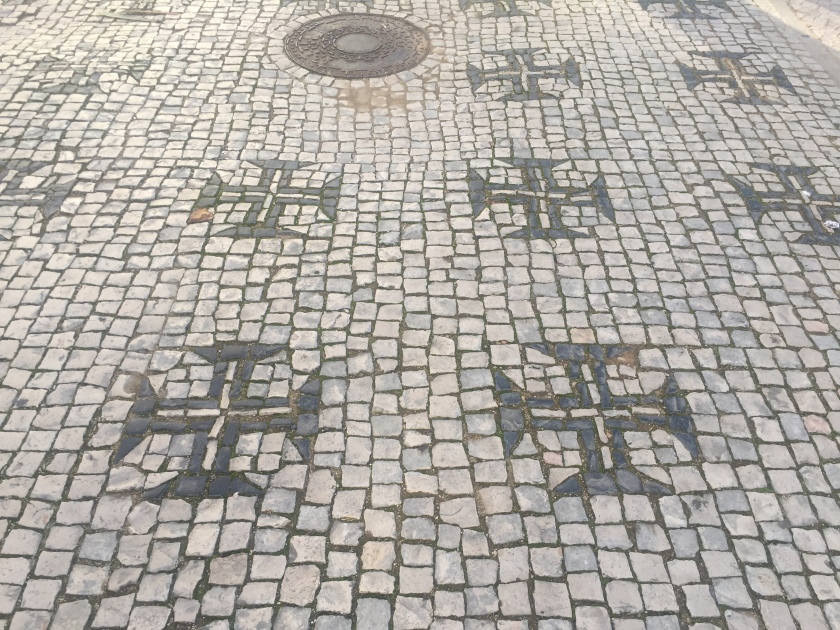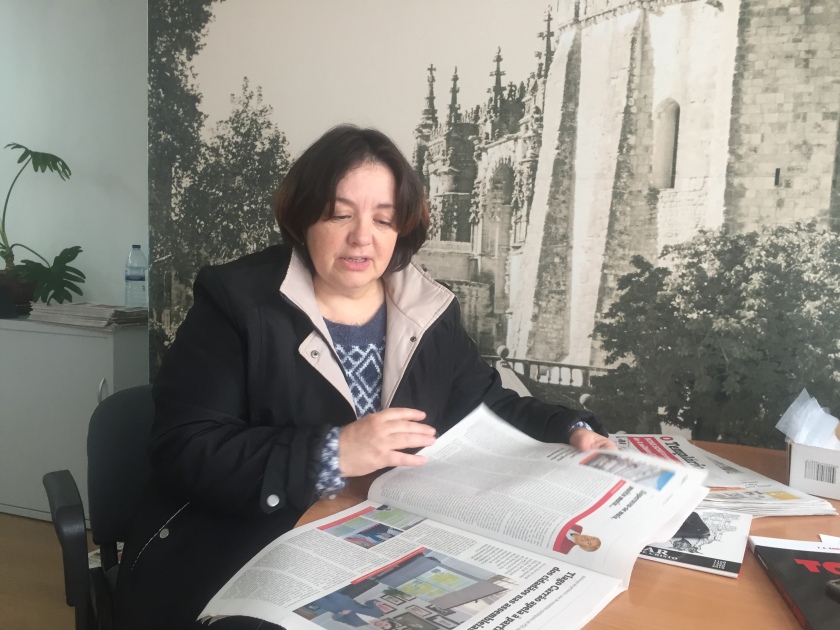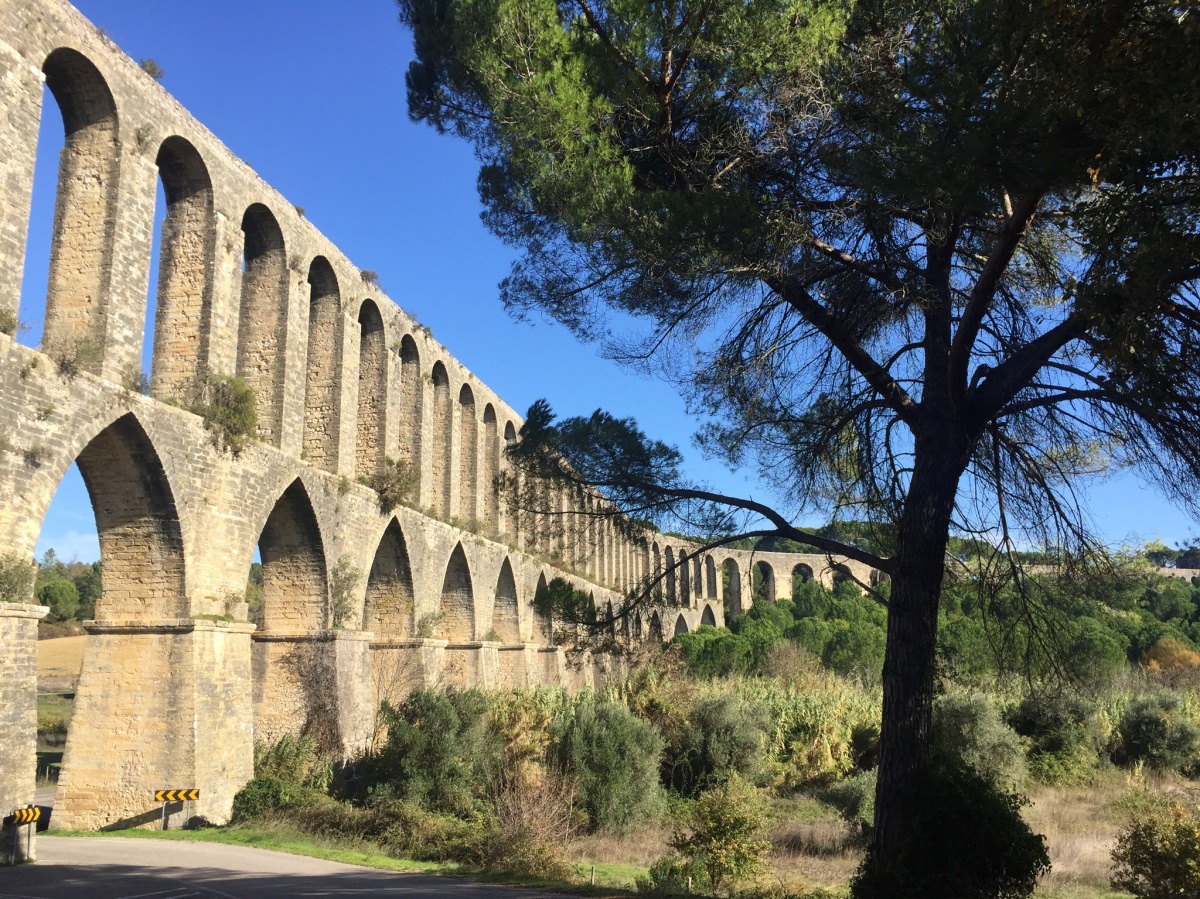From Fátima I headed east on a 30-km waymarked route to the town of Tomar, which is astride the pilgrims’ way from Lisbon to Santiago de Compostela. The Fátima to Tomar spur, marked with yellow signs for Santiago, is called the “caminho nascente” (rising path), because you are walking in the direction of the rising sun. The route was mainly quiet country roads with some woodland tracks.
The prosperity of Fátima quickly gave way to the kind of Portuguese village I had seen so often, with stone houses falling down, deserted streets and a general air of abandonment. It wasn’t all desolation; there were occasional signs of life like a cafe or a well-tended garden.
On one occasion I spotted a boy, aged perhaps nine or 10, helping with the olive harvest. It was the first time in rural Portugal that I had seen a child on a farm.
The glory of this route is the remarkable aqueduct of Pegões, just west of Tomar, and I didn’t want to miss that. I spent a night in a pilgrims’ hostel in the village of Fungalvaz so that I could walk past the aqueduct in broad daylight the next morning. The hostel, right next to the church, was well-equipped and even boasted a bottle of Scotch whisky in the kitchen.
The Pegões aqueduct was worth the wait. In the late morning it came into view on my left, an extraordinary six-kilometre long stone structure with two levels of arches, snaking through the countryside. It was built between 1593 and 1614 to take water to Tomar’s Convento de Cristo.
I walked into Tomar in bright sunshine and children were skating on a small ice rink in the town’s main square. It all felt suitably festive in the run-up to Christmas.

I immediately took a liking to Tomar, a pretty town with swans and ducks gliding on the river Nabão and a rich history rooted in the traditions of the medieval Knights Templar who began as an order of poor monks and evolved into an elite fighting force in the Crusades. Having accumulated power, the Knights Templar came to a bad end in the early 14th century at the hands of a French king and in popular fiction they are sometimes portrayed as villains. But in Tomar they are highly revered. Tomar’s main square is dominated by a statue of Dom Gualdim Pais, the Templar Grand Master who founded the town in the 12th century. The Templar cross, narrow at the centre and broader at the periphery, adorns the pavements. The town’s newspaper, predictably enough, is O Templário.
In most of Europe the Knights Templar were annihilated in the early 14th century. But Portugal followed its own path. After the Templars were abolished by papal bull in 1312, in Portugal they rose again under the protection of King Dinis I, with the new name of the Order of Christ. They were very powerful in late medieval Portugal and helped to finance the epic sea voyages in the Age of Discoveries.
Above the town is the Convento de Cristo, the Templars’ former headquarters. This is one of the extraordinary buildings of western Europe, a very atmospheric complex of chapels and cloisters set within 12th century walls. The Charola, a 16-sided Templar church adorned with 16th century wall paintings, is the jewel in the crown. According to the Lonely Planet guide: “It’s said that the circular design enabled knights to attend Mass on horse-back.”
Tomar is pretty much in the heart of Portugal and after visiting the Convento de Cristo I decided to step back from the day-to-day sightseeing and take the pulse of the country. My own judgment is that Portugal is a relaxed, super-friendly country to travel through, but perhaps too relaxed for its own good. The slow death of so many inland villages looks to me like a sign of drift, of a country sleepwalking into difficulties. There are some voices in Portugal sounding an alarm. Parliamentary deputy Luis Leite Ramos has warned that two-thirds of the country could become depopulated.

To get some views on the state of Portugal I talked to Isabel Miliciano, director of O Templário and the weekly newspaper’s one full-time journalist. I quickly discovered that she had some firm views on Portugal, which she described as being in crisis.
“I see two serious problems in Portugal – the destruction of production and corruption. These are two very serious problems,” she said.
Much of our conversation in the small office of O Templário focused on these two themes.
She spoke of Portugal’s brush with bankruptcy after the financial crisis of 2008 and said that globalisation had led to the closure of many Portuguese factories. “We here in Tomar had many paper factories. We produced paper since the 19th century. Textiles, we had a textile factory that was one of the first in Europe, the Fiação factory which had 1,500 workers. Everything has closed. During the last 15 to 20 years they gradually closed. The last paper factory closed last year (2017). It was called Prado. Today we are importing paper from Spain and other countries.
“All this meant that the country went into an economic recession. Our politicians and high Portuguese financiers became corrupt. We had one prime minister taken prisoner. He is still to go on trial…”
Miliciano was referring to the former Socialist prime minister José Sócrates, who in October 2017 was indicted on graft and money laundering charges. The indictment said he had received millions of euros from a scheme involving the disgraced former bosses of the Espírito Santo banking empire and Portugal Telecom which have both ceased to exist. Sócrates has denied the charges. In all 19 individuals from the country’s elite were charged in the biggest corruption case in modern Portuguese history, Operation Marquês.
She painted a picture of a country which had been on the brink of bankruptcy and received a reprieve from an international rescue package of 78 billion euros in loans in 2011 and the boom in tourism. But she still fretted about Portugal’s longer-term future.
She touched on the theme of the continuing brain drain from western Europe’s poorest country. “German companies come here to recruit engineers,” she said. “The United Kingdom comes to look for nurses…Our country makes the effort to train good professionals, but afterwards it doesn’t get benefit from them. It lets them leave.”
Finally we touched on the phenomenon of Portugal’s falling population. Miliciano has her finger on the pulse of Tomar’s population since her newspaper publishes the births and deaths in the municipality. She said that every year about 500 people died in Tomar, while between 200 and 250 babies were born. She said couples were often reluctant to have children because of the cost.
“We earn money just to eat, to pay the rent,” she said. “We live day to day, we don’t build up a reserve.”
The number of people on Tomar’s electoral roll, she said, had dropped by about 3,000 since 2011. Tomar now has a population of about 35,000, divided equally between the town and the surrounding countryside.
It was sobering to listen to this downbeat assessment from Miliciano. Tomar, after all, is in a very fertile region, the Ribatejo, watered by the river Tejo.
I walked out from O Templário and into a local museum hosting an exhibition on the wildfires that ravaged Portugal in 2017, causing more than 100 deaths and burning about 520,000 hectares of forest. This represented nearly 60 percent of the forests burned in the entire European Union.
In the museum I talked to Filipe Martins, who had helped to take some of the photographs for the exhibition. He too was downbeat, echoing themes developed by Miliciano. “We are not producing anything. We are leaving our land abandoned,” said the 28-year-old studying photography in Tomar. On a scale of zero to 10, how did he gauge the economic and social well-being of Portugal? He gave the country a three. Would he stay in Portugal when he graduated? “I would like to stay in Portugal, but if I got a better opportunity than here I would probably go,” he said.
Seeing a welcoming Union Jack on the door of an estate agent’s office, I dropped in and talked to Patricia Henriques. It is an estate agent’s vocation to be upbeat and she was. From her perspective business was good, but she did note that foreigners accounted for between 30 and 35 percent of her clients. She had British, Brazilian, Australian and French buyers in particular. Without them, things would be quiet. “I joke that Portugal is being sold off to foreigners,” she said, hastening to add that this was better than houses falling down. She was more optimistic than the student about the state of her country, giving it six out of 10.
When I left Tomar centre and walked south out of the town I finally saw what Miliciano the newspaper director had stressed – the closure of industry. One big building after another was abandoned. At a former cement works a little south of Tomar there was still a table and two chairs in the reception office at the entrance. Economic decline is part of the ebb and flow of human affairs, but there is always something arresting about stillness where once there was bustle.

